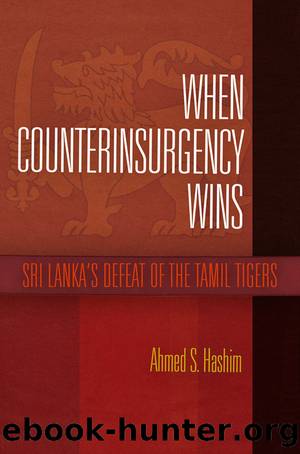When Counterinsurgency Wins: Sri Lanka's Defeat of the Tamil Tigers by Ahmed S. Hashim

Author:Ahmed S. Hashim [Hashim, Ahmed S.]
Language: eng
Format: epub
Tags: History, Political Science, Terrorism, Security (National & International)
ISBN: 9780812206487
Google: 9AKqCT5DeZcC
Goodreads: 16468922
Publisher: University of Pennsylvania Press
Published: 2012-11-16T00:00:00+00:00
The Battle for Vakarai
It was, however, the difficult battle for the small, run-down coastal village of Vakarai on the decrepit A-15 âhighwayâ that proved the SLA had made considerable progress in professionalism and innovation.8 The military operation was conducted in two main phases. The 23rd Division headquartered at Welikanda was in overall command. Former military spokesman Major General Daya Ratnayake was the general officer commanding (GOC) of the division at the time. The offensive was spearheaded by special forces units under Colonel Prasanna de Silva and included the following infantry units: 6th GW (Gemunu Watch), 7th GW, 8th GW, 10th GR (Gajaba Regiment), 8th GR, and 6th VIR (Vijayabahu Infantry Regiment). These infantry and special forces units were provided with effective and efficient combat service support by armored, artillery, and engineering corps to overcome the entrenched defenses and numerous obstacles the LTTE had set up.
The military launched the first phase of the attack between October 2006 and January 2007, during which ground units made four consecutive efforts to advance into LTTE-held areas and succeeded in loosening LTTE control over several outlying areas. Extensive reconnaissance missions by special forces and commandos deep inside enemy-held territory facilitated accurate artillery and air strikes on LTTE formations; these units had personnel trained in calling down artillery and air strikes (forward air controllers, FACs). Constant SLN patrolling off the coast prevented the LTTE from bringing in reinforcements from the Wanni jungle or retrieving their big guns and other equipment from the east. The Sri Lankan military infiltrated elite long-range reconnaissance patrol (LRRP) teams behind LTTE lines; they kept the enemy off balance with a series of surprise assaults in multiple locations. These attacks forced the LTTE to disperse its cadres to deal with the multiple threats and allowed civilians who had been closely watched to flee the theater of operations. Following completion of the first phase of attack by the special forces and commandos, infantry units marched into the newly captured territories to consolidate government control. The operational methods of the past, whereby the army would clear an area of the LTTE and then vacate itâallowing the insurgents to reinfiltrateâwould now be avoided.
The army then made preparations for the second stage of the operation, which commenced on January 16, 2007. Four days of intense battle ensued. The infantry followed the special forces units, which were specifically tasked to take out LTTE bunkers and position.9 The forces moved forward in two axes of attack, from Kadjuwatta and Mahindapura, to put pressure on the LTTE from the north and south. LRRP teams supported by infantrymen marched into the Trikonamadu jungle from the Mavil Aru and Madurankerni Kulam areas to ambush possible enemy reinforcements moving into the area of combat operations and to intercept, capture, or kill any LTTE cadres fleeing the battlefield.
Early on the morning of January 18, 2007, special forces commenced their advance from the 2nd LTTE defensive lines, which they had captured south of Panichchankerni. After a short but intense firefight, they captured the 3rd LTTE bunker line by early evening.
Download
This site does not store any files on its server. We only index and link to content provided by other sites. Please contact the content providers to delete copyright contents if any and email us, we'll remove relevant links or contents immediately.
| Central Asia | Southeast Asia |
| China | Hong Kong |
| India | Japan |
| Korea | Pakistan |
| Philippines | Russia |
The Sympathizer by Viet Thanh Nguyen(4344)
The Rape of Nanking by Iris Chang(4170)
World without end by Ken Follett(3446)
Ants Among Elephants by Sujatha Gidla(3442)
Blood and Sand by Alex Von Tunzelmann(3168)
Japanese Design by Patricia J. Graham(3139)
The Queen of Nothing by Holly Black(2546)
City of Djinns: a year in Delhi by William Dalrymple(2533)
Foreign Devils on the Silk Road: The Search for the Lost Treasures of Central Asia by Peter Hopkirk(2445)
India's Ancient Past by R.S. Sharma(2433)
Inglorious Empire by Shashi Tharoor(2414)
Tokyo by Rob Goss(2408)
In Order to Live: A North Korean Girl's Journey to Freedom by Yeonmi Park(2362)
Tokyo Geek's Guide: Manga, Anime, Gaming, Cosplay, Toys, Idols & More - The Ultimate Guide to Japan's Otaku Culture by Simone Gianni(2346)
India's biggest cover-up by Dhar Anuj(2337)
The Great Game: On Secret Service in High Asia by Peter Hopkirk(2318)
Goodbye Madame Butterfly(2231)
Batik by Rudolf Smend(2155)
Living Silence in Burma by Christina Fink(2049)
